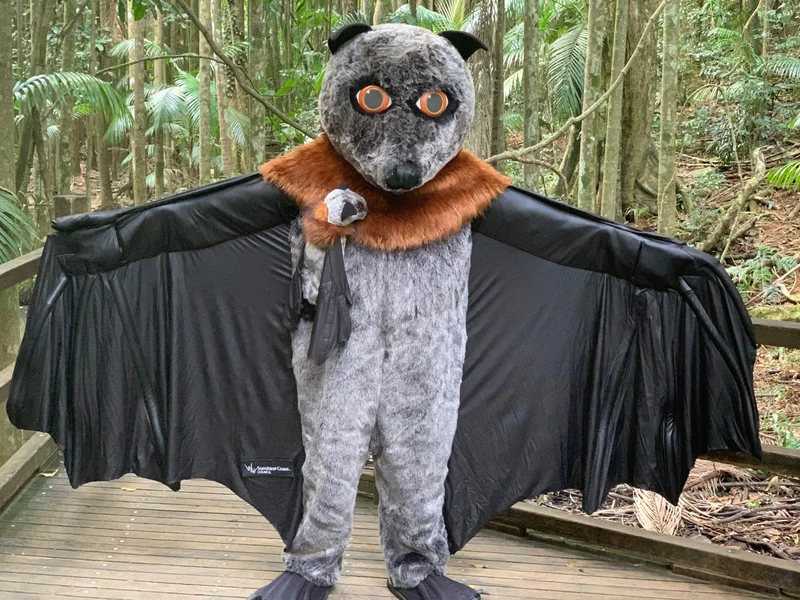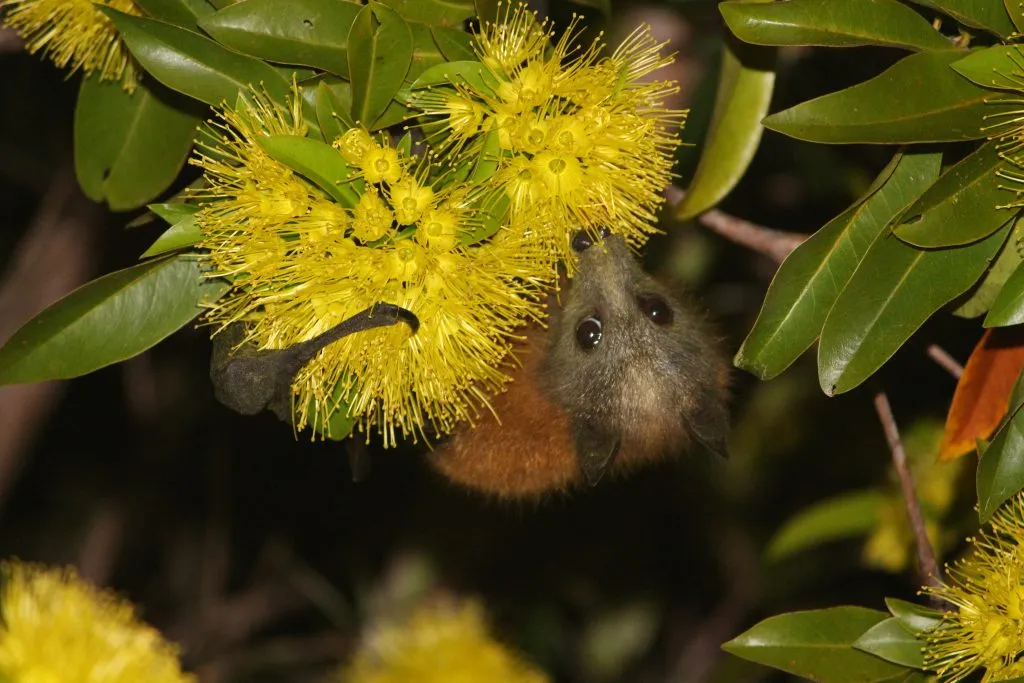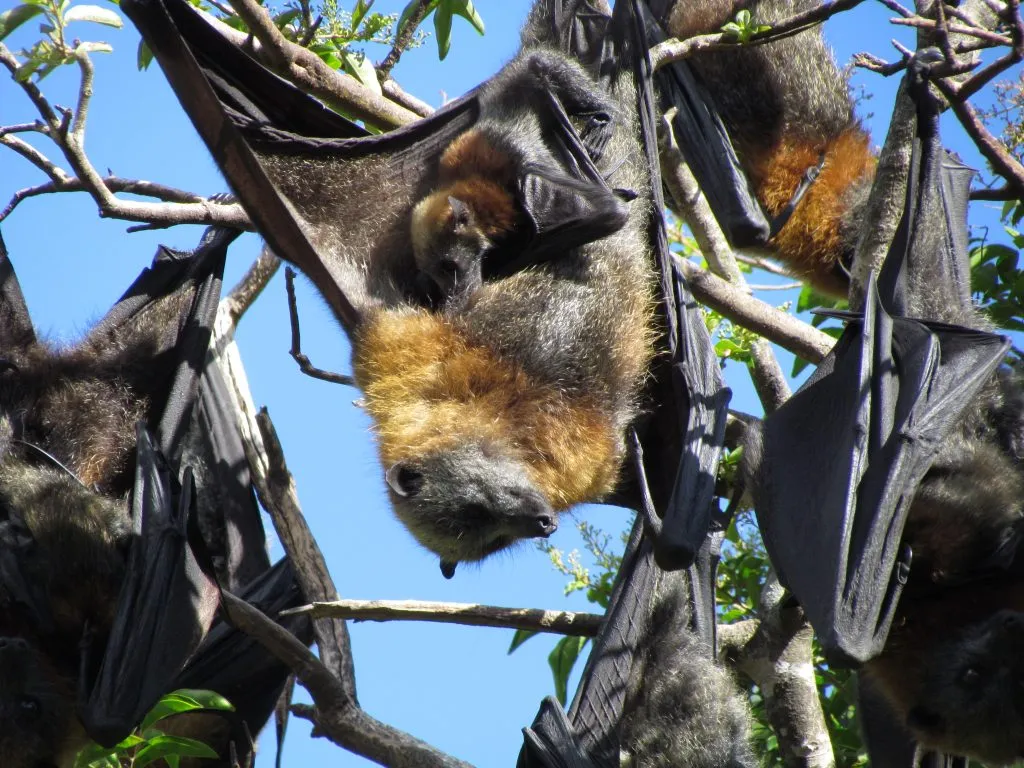A year in review for flying foxes

You might be wondering what the flying-foxes have been up to all year?
Well, we’d love to give you a recap, and tell you all about what the flying-foxes of the Sunshine Coast typically get up to all year long.
January
To start the year off we generally have all three of our local flying-fox species visiting us all here on the Sunshine Coast. The Black flying-fox, Grey-headed flying-fox, and Little Red flying-fox.
The Black flying-fox and Grey-headed flying fox are our longer-term furry neighbours, periodically making use of summer and winter roost all across the Sunshine Coast all year round.
At this time of year, the young of both the ‘blacks’ and ‘greys’ are becoming independent and learning to fly. Once this happens, and the young flying-foxes pass flying-school, they start leaving their mothers to form into separate groups of juveniles either at the edge of their existing roost or at another site. These we commonly call ‘bachelor camps’ and are the beginning of new social grouping structures.

A grey headed flying fox
February - What’s that smell?
This time of year, our males start to form their mating territories before the mating season occurs over March and April. This includes marking territories and attracting mates with a very distinct and strong odour from glands on their shoulders that they wipe on branches.
You may be able to smell this increased odour. And it can be particularly impactful after rain (when flying-foxes re-mark the trees), and in hot and humid weather (welcome to summer on the Sunshine Coast!).
You can try and reduce this impact by closing your windows, circulating air with an air conditioner, and including things like scented candles or incense inside your home to make this period more bearable and pleasant.
March - April - What’s that noise?
Mating season has begun! Adult black and grey-headed flying-foxes have now began mating, and in the process are making a lot of noise doing it. This can occur for almost 24 hours a day, and for around four weeks during this eight-week period. This can be the most disruptive time of year if you happen to live nearby these noisy neighbours.
But don’t stress! We still hear you over all the noise from mating activities. Council have continued efforts to reduce the impacts from high-impact urban roosts. These actions are governed by our Regional Flying-fox Management Plan, which has been endorsed by the Queensland Government, and is approved by the Australian Government as a conservation agreement.
Our main management actions include:
• understorey weed reduction
• roost tree removal
• habitat restoration
• sprinkler system deterrents.
To learn more about what council are doing at each roost site, check out our BatMap webpage.
May – June – July - August
Brrrr! You may have noticed a temperature change as the seasons shift and Winter sets in. However, this isn’t the only shift happening on the Sunshine Coast at this time of year.
During the winter months our ‘greys’ and ‘blacks’ move from their coastal ‘Summer’ roosts to their ‘Winter’ roosts.
Why is this you ask?
To celebrate CHRISTMAS IN JULY of course!!
These Winter roosts are selectively chosen based on their close proximity to winter flowering plants where our now pregnant mummas in their gestation period celebrate and indulge and eat and eat and eat! This way the mums can fatten themselves up and prepare to soon rear their young.
September - October

Baby flying fox clinging to its mother's belly
Once again, a change in seasons means a change in flying-fox roosts as the greys and blacks return to their summer roost sites as the weather heats back up! These coastal summer roosts are also referred to as maternity roosts as the now extremely full mummas give birth to their young (also known as a pup) and remain at this site until the young become independent.
Flying-fox pups are completely dependent on their mummas to survive, clinging to her belly for around 6-8 weeks. After this, the babies get put into a ‘creche’ (like a flying-fox day-care) where each of the mums take turns heading out and feeding each night. When they return, the mums can identify their individual pup from their distinct call. As newborns call for their mother, maternity roosts will start to get noisier at night.
Did you know?
If stressed or disturbed in late-stage pregnancy or early after birth, mothers may abort foetuses or abandon their young. Where possible, Sunshine Coast Council will avoid management actions during this period.
November
This time of year, mums continue to care for and nurture their bubs. Flying-fox pups feed on their mother’s milk from her teat located under her armpit for a massive 5-6 months long, before they start to become independent. A MASSIVE shout out to all those fantastic mothers out there! Furry or not you know who you are.
December - January
And that’s a wrap!
Quite literally our mummas will unwrap their wings they have used to tightly clutch their babies as they become more and more independent and venture into the big wide world.
Learn more about flying foxes at on council's website.
Last edited on:
First published on: